
The majority of Ia Drang battle narratives in the current American literature are based on Hal Moore's We Are Soldiers Once … and Young, Hal Moore's After Action Report, IA DRANG Valley Operation 1st Battalion, 7th Cavalry 14-16 November 1965 , Kinnard's Pleiku Campaign and Coleman's Pleiku, the Dawn of Helicopter Warfare in Vietnam. Although these are primary sources, they only provide bits and pieces of the action and maneuvers that appeared incoherent and irrational.
A typical inaccurate narrative of the battle has the following scenario (Daddis, No Sure Victory: Measuring US Army Effectiveness and Progress in the Vietnam War, page 124-135):
- On October 23, General Kinnard rushed in an entire Air Cav Brigade and rescued Pleime camp;
- On October 26, General Kinnard committed the entire Air Cav Division in pursuit of the withdrawing NVA troops;
- General Man regrouped his forces in Chu Pong massif and waited for the next Americans' move;
- On November 14, General Kinnard ordered LTC Hal Moore to use air assault tactic in attacking the NVA troops at LZ X-Ray;
- On November 15, 1/7 Air Cav Battalion's defensive perimeters became so desperate that General Kinnard had to call in a B-52 airstrike to save the battalion;
- On November 17, the NVA troops used the "grab him by the belt" and defeated 2/7 Air Cav Battalion at LZ Albany.
This depiction of the battle is way off the mark.
To get the whole picture of the battle, more complementary details and information provided by the following primary sources are needed: McChristian's Intelligence Aspects of Pleime-Chupong Campaign, Larsen's G3 Journal/IFFV, 10/20-11/26/1965, Vinh Loc's Why Pleime, and Vinh Loc's Pleime, Trận Chiến Lịch Sử.
To this list, one might want to get some additional information from the Viet Cong documents, such as: Nguyen Huu An’s Chiến Trường Mới (New Battlefields); Nguyen Nam Khanh’s Chiến thắng Pleime-Ia Drang (Pleime-Ia Drang's Victory); and Dang Vu Hiep’s Người Chính Ủy Trong Trận Đầu Thắng Mỹ ở Tây Nguyên (The Political Commissar at the First Battle Against the Americans in Central Highlands).
It is only through a thorough and in-depth study of all these documents that one can expect to ascertain the whole truth of the Ia Drang battle.
But first of all, a clarification in terms of the appellation is needed:
Ia Drang battle - which occurred from November 14 to November 17 - should be instead called Chupong battle or LZ X-Ray battle. It was the second phase in the three-phase Pleime-Chupong-Iadrang campaign.
The Chupong phase - which occurred from October 27 to November 17 - is also called the Pleiku campaign by Kinnard, or Long Reach operation by Vinh Loc, or the Pleime-Chupong campaign by McChristian. This phase comprises three operations conducted by 1st Air Cavalry Division: All the Way of 1st Air Cavalry Brigade (10/27-11/9), Silver Bayonet I of 3rd Air Cavalry Brigade (11/9-11/17, with LZ X-Ray battle from 11/14-11/16 and with LZ Albany battle on 11/17) and Silver Bayonet II of 2nd Air Cavalry Brigade (11/18-11/26).
The Ia Drang phase - which occurred from November 18 to November 26 - is also called Than Phong 7 operation and was performed by the ARVN Airborne Group.
The unfolding of these three phases was dictated by a well-thought operational concept that used B-52 airstrike to destroy the three NVA regiments at Chupong. Two requirements must be met to achieve a successful Arc Light strike: (1) the three regiment force had to concentrate with its center of mass vic XX'YY' and (2) remained immobile long enough because B-52 bombers needed an eight-hour flight from Guam to Chupong. The first requirement could be achieved when the three regiments had to regroup for re-equipment, re-organization and rehearsals if they intended to stage for an attack. The second requirement could be met with a diversionary maneuver.
This plan was studied and formulated in September when II Corps Command learned that B3 Field Front Command intended to attack Pleime camp with the three 32nd, 33rd and 66th Regiments and used Chupong massif as the staging area (Intelligence Aspects of Pleime-Chupong campaign, page 6):
The Chu Pong base was known to exist well prior to the Pleime attack and J2 MACV had taken this area under study in September 1965 as a possible B-52 target.
Phase I - Pleime
B3 Field Front Command's initial plan was to launch the attack by December 1965. To avoid the participation of American troops that were massing in II Corps early October, B3 Field Front Command opted for an earlier attack with only two 32nd and 33rd Regiments present and ready in Central Highlands on October 20.
II Corps Command had to hold off using Arc Light strike and worked out a counter-attack plan that would entice B3 Field Front to regroup its three regiments for a second attack, providing the B-52 bombers the opportunity to destroy the three regiments altogether. For that, II Corps Command only committed two US-ARVN Special Forces companies to reinforce Pleime camp and a 1000-troop Relief Task Force with Dan Thang 21 operation (Pleime, Trận Chiến Lịch Sử, page 94):
Dan Thang 21 operation finished, Pleime camp was back on its footing, but among the two VC Regiments that had joined in the attack, we only inflicted the enemy with more than 400 killed. The withdrawal was a rational and intelligent initiative taken by the VC Field Front Command. But the enemy would attempt to take revenge and furthermore, the remote Pleime camp remains an eyesore to them.
Phase II - Chupong
Knowing that B3 Field Front Command remained eager to overrun Pleime camp, II Corps Command assigned to 1st Air Cavalry the conduct of Long Reach operation which comprised two phases: (1) herding the two 32nd and 33rd Regiments to Chupong massif; (2) enticing them to regroup with 66th Regiment to stage a second attack of Pleime camp with a switch of operational direction from west to east.
And to entice B3 Field Front Command to consider attacking Pleime camp again, II Corps Command kept the camp and its immediate surroundings under ARVN's responsibility, while assigning the new operational areas to 1st Air Cavalry Division (G3 Journal/IFFV, 10/30):
- 00:50H: II Corps (Major Black) At 292350 Col Williams called Col Hieu, CofS II Corps. II Corps requested that 1st Cav TAOR be extended to include the Plei Me area except the camp itself. From present line on NS grid line ZA14 east to NS grid line AR77, on EW grid line ZA/AR15, south on AR77 to EW grid line 00, then west to NW grid line ZA14. Col Buchan, Gen Knowles, Col Williams and Col Mataxis agree.
This arrangement made Pleime camp appeared still vulnerable for an attack and remained appealing to B3 Field Front Command.
The herding task was assigned to the 1st Air Cavalry Brigade with All the Way operation. Company sized of air cavalry teams harassed the decimated and scattered NVA small units back to Chu Pong. The herding operation was closely monitored by G2/II Corps (Intelligence Aspects of Pleime-Chupong campaign):
- By the end of 10/27, the lead elements of the 33d had closed on it forward assembly area, the village Kro (ZA080030), while its rear-guard battalion, was just beginning to break contact at the Pleime CIDG camp.
- On 10/28, the 32d Regiment had nearly closed its base on the north bank of the Ia Drang.
- On 10/29, the 33d Regiment was headed for its "home" prior to the attack on Pleime. This was Anta Village at YA940010.
- On 10/31the enemy units continued to disintegrate and fragment into small parties; furthermore, the 33d experienced shortage of food and medicines since many units could not reach their pre-stocked supply because of the sudden thrusts of the helicopter-borne troopers.
- On 11/01, the 1st Air Cavalry Division discovered and destroyed a VC field hospital well equipped with medicines and surgical instruments; and the regimental headquarters had reached the base at Anta village, but the bulk of the regiment was still strung out between Pleime and Chu Pong.
- On 11/02, the 66th Regiment began moving into assembly areas in the Chu Pong-Ia Drang area.
- On 11/03, elements of 1st Air Cavalry Brigade conducted an audacious ambush in the very heart of the Chu Pong - Ia Drang complex against the 8th Battalion of the newly-infiltrated 66th Regiment. Also the 33d Regiment, meantime, was still trying to pull its bruised and battered tail into the Chu Pong sanctuary.
- On 11/04, the 33d Regiment was ordered out of its base at Hill 732, which it had hardly reached, and onto the eastern slopes of Chu Pong in the vicinity of YA922010 with its battalions (when they closed) to take up positions from Hill 732, down through Anta Village (940010) to the north bank of the Ia Meur (980000). Also, the fragmented bits and pieces of the regiment were still making their way in a generally westward direction, clinging to stream beds, utilizing all available concealment to avoid detection by the ever-present Cavalry helicopters. There still was one unit reasonably intact - the battalion that had acted as rear guard. Starting later and moving more slowly than the rest, it was still east of main Cavalry positions.
- On 11/05, the 66th Regiment continued to close into assembly areas in the Chu Pong sanctuary and the 33d Regiment waited for its shattered forces to rejoin the parent unit. The 32d Regiment and Field Front, meanwhile, remained untouched and untroubled north of the Ia Drang and adjacent to the Cambodian frontier.
- On 11/07, in the Chu Pong sanctuary the depleted 33d Regiment licked its wounds and waited for its stragglers to come in.
- On 11/08, only fragmented units and stragglers remained east of the Chu Pong-Ia Drang complex.
- On 11/09, the Field Front headquarters was at north of the Ia Drang.
At this point, the herding phase ended and was followed by the enticing phase which was assigned to the 3rd Air Cavalry Brigade with Silver Bayonet I operation. 3rd Air Cavalry was ordered to switch the direction of enemy search operations from west to east (Pleiku Campaign, page 67):
By this time Field Force Vietnam had asked the division to consider moving this operation east of Pleime if it appeared that was no further contact imminent in the west,
aiming at letting B3 Field Front to believe that the American troops had lost the enemy tracks (Pleiku Campaign, page 73):
The movement and shift in emphasis from west to east were to further stimulate a forthcoming decision from the NVA division headquarters.
and that it was the appropriate time to switch to an offensive posture in preparation for the second attack against Pleime camp (Pleiku Campaign, page 76):
With American units seemingly withdrawing to the east of Pleime, the decision was to attempt to regain its early advantage with an attack. The target once again was the Pleime CIDG Camp. The division headquarters set the date for attack at 16 November, and issued orders to its three regiments.
B3 Field Front fell for the ploy, and on November 11, ordered the three regiments to regroup in assembly areas in preparation for an attack set for November 16.
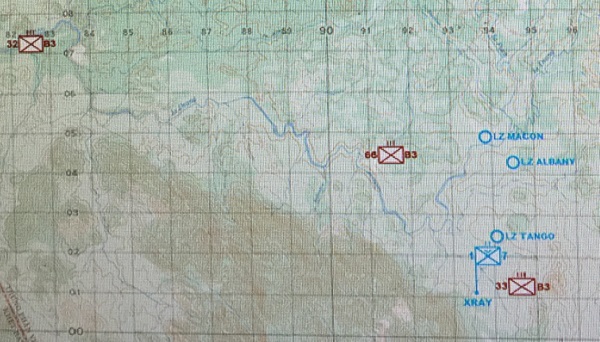
II Corps Command seized the opportunity and set Arc Light strike for November 15 afternoon.
1/7 Air Cavalry Battalion was sent into Chupong at LZ X-Ray on November 14 to fix the three NVA regiments at their assembly areas. The insertion caught the attention of B3 Field Front Command that decided to postpone the attack of Pleime camp and to meet the new threat with two 7th and 9th battalions of 66th Regiment while the other units of 32nd and 33rd stayed put at their positions. 1st Air Calvary countered with the reinforcement of 2/7 Air Cav Battalion that closed in by 9:15 am on November 15. When the situation required the reinforcement of a third battalion to rescue an isolated platoon, 2/5 Air Cavalry Battalion was sent in by foot from LZ Victor, so that B3 Field Front Command did not realize the balance of opposing forces had changed from 2:2 to 3:2 and maintained statu quo the positions of its units (General Nguyen Huu An):
At the forward command post, we grasped a better control of the situation at this moment. 66th Regiment reported back: 9th Battalion was able to establish communication with 7th Battalion. Thus, the balance of forces in this narrow area was two battalions for each side, with the American side higher in troop numbers, not counting two artillery companies and air force enforcements,
and B-52 bombers were able to drop their first waves of bombs over the positions of 32nd and 33rd Regiments precisely at 16:00 hours.
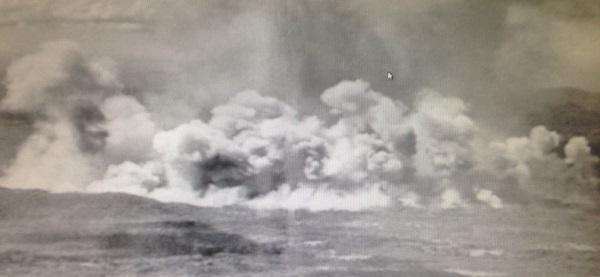
The Arc Light strike carried on with four more waves on that day and resumed the next day, aiming at destroying those two regiments. On November 16, 1/7 Air Cavalry Battalion was extracted, so that B3 Field Front did not feel the necessity to rush in more troops into the battlefield. On November 17, the remaining two 2/7 and 2/5 Air Cavalry Battalions were ordered to quietly move out to allow B-52 bombers to strike the positions of 66th Regiment in and around LZ X-Ray.
The Arc Light strike carried on for 5 consecutive days (Why Pleime, chapter VI):
For five consecutive days, from 15 to 19 November, the giant B52 bombers had flown a total of 96 sorties. One after the other, the areas of the Chu Pong massif - each of 20 square miles - underwent a systematic earthquake spreading from West to East. VC bunkers and trenches which so far had resisted the strikes by tactical aircraft and artillery began to score direct hits by the 750-pound bombs. The heavy canopy of the jungle ceased to be effective in both concealment and cover. The "back door" into Cambodia was closed and to escape, the VC remnants were reduced to utilize the narrow valley of the Ia Drang.
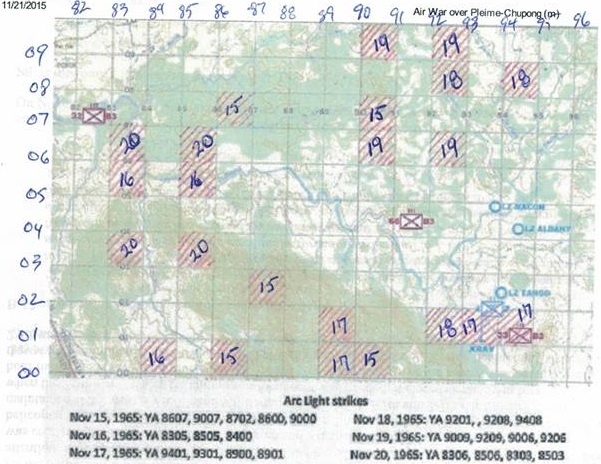
On November 15 and 16, B-52 airstrikes aimed mainly at the positions of units of the 33rd and 32 Regiment; on November 17, 18 and 19, units of the 66th Regiment; and on November 20, units of the 32nd Regiment.
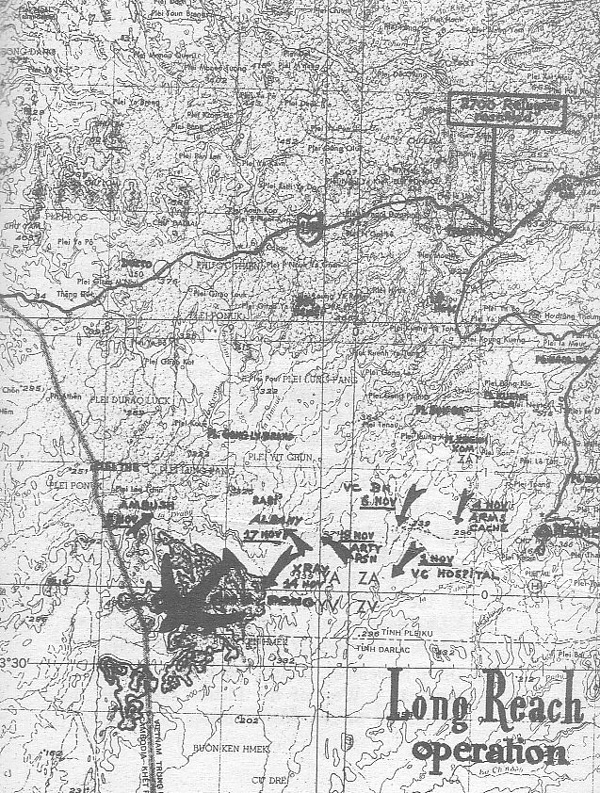
General Knowles reveals that the purpose of the insertion of the Air Cavalry troops at LZ X-Ray on November 14 was to “grab the tiger by its tail” and to hit its head with B-52 airstrikes from November 15 to 16. He also explains the reason for pulling out of LZ X-Ray on November 17, and moving to LZ Albany was “to grab the tiger by its tail from another direction” and continued to hit its head with B-52 bombs from November 17 to 20.
Phase III - Iadrang
By November 17, 1965, after three days of B-52 strikes, II Corps Command estimated that the enemy had lost two-thirds of its forces, and determined it was time to finish off with the two remaining units - 334th and 635th Battalion - and to terminate the Pleime campaign by bringing in the ARVN Airborne Group comprising 5 Airborne Battalions to execute a surgical strike with Than Phong 7 operation.
1st Air Cavalry provided the artillery firepower support with the establishment of a new firebase set up at LZ Crooks, secured by 2nd Air Cavalry Brigade.
The Airborne Group achieved its mission with two ambushes: the first one on the north side of Ia Drang River, destroying 334th Battalion on November 20; and the second one on the south side of the river, destroying 635th Battalion on November 24.
The Pleime-Chupong-Iadrang campaign ended with these two victories, and the Airborne Group was extracted on November 26, 1965.
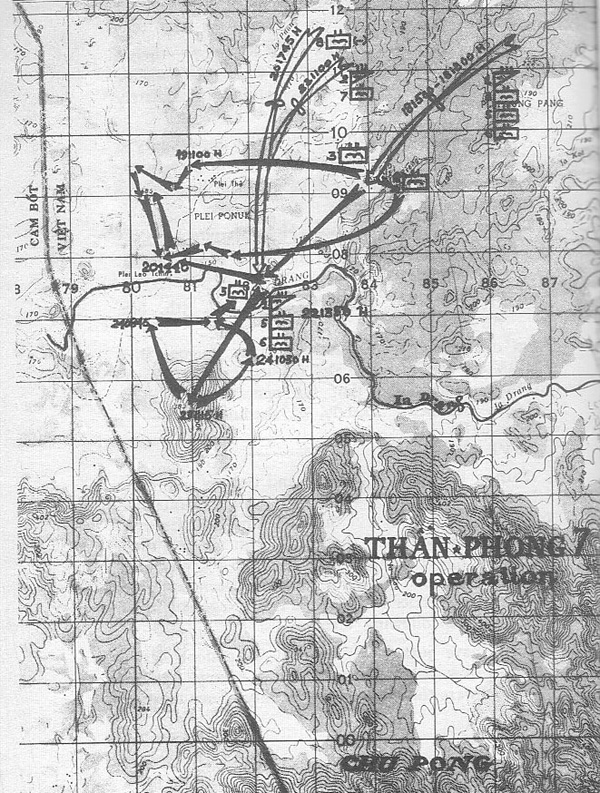
Conclusion
Inaccurate narratives of Ia Drang battle stemmed from
- assuming it was inclusively an American operation, while it was, in fact, an ARVN-US joint operation with a clear cut "modus operandi" advanced by II Corps Command: joint intelligence and support activities and commonly-shared concept of operations and results; but separate TAOR, command, deployment of forces, conduct of activities and reserve (Why Pleime, chapter VIII);
- considering it as a stand-alone battle, while in fact, it was an integrated piece of the action in a vast scheme named Pleime-Chupong-Iadrang campaign;
- and not being aware of the operational concept - that dictated all the maneuvers - using B-52 airstrike to annihilate the three NVA regiments in Chupong massif.
Nguyen Van Tin
24 July 2014
- Operation Pleime-Chupong B-52 Strike?
- The Use of B-52 Strike in Ia Drang Campaign, General Westmoreland’s Best Kept Military Secret
- Air War Over Pleime-Chupong
- Arc Light over Chu Pong Operation
- Catching a Thief Tactic in Pleime Campaign
- Pleime/Chupong Campaign Destroying B3 Field Front Base
- The Uniqueness in Pleime Counteroffensive Operational Concept
- Pleime Counteroffensive into Chupong Iadrang Complex
- The Unfolding of Strategic and Tactical Moves of Pleime Campaign
- Battle of Pleime
- The Truth about the Pleime Battle
- Intelligence Gathering at Ia Drang
- Intelligence, the Key Factor in the Pleime Campaign's Victory
- Roll Call of Combatants at Pleime-Chupong-Iadrang Battlefront
- "Victory at Pleime" ?
- Tactical Moves in Pleime Battle
- Kung Fu Tactics at Pleime Campaign
- Various Diversionary Moves in Support of Arc Lite Strike in Pleime Counteroffensive
- What if there was no master plan for Pleime Counteroffensive?
- Pleime/Chupong Campaign Destroying B3 Field Front Base
- A Few Things You Should Know about Pleime-Iadrang Campaign
- Things the VC Don't Want People To Know at Pleime Battle
- Reviewing "Why Pleime"
- Review of "Intelligence Aspects at Pleime_Chupong Campaign"
- Perplexing Maneuvers at Pleime-Chupong-Iadrang You Might Be Attempted to Question
- A Bird’s-Eye-View of Pleime Campaign
- Operation Dan Thang 21
- US Air Force’s Roles in Pleime Campaign
- Arc Lite Operation Planning and Execution in Pleime Offensive
- A Doctrinal Lesson on the Use of Arc Lite in Pleime Counteroffensive
- Command and Control of Arc Light Strike at Chupong-Iadrang
- A Military Genius in Action at Pleime-Chupong-Iadrang Battlefront
- Command and Control Skills in Pleime Campaign
- Behind-the-scenes Activities at Various Allied Headquarters During Pleime Campaign
- The Two Principals Players Of Pleime Chess Game
- Pleime Battle's Diary
- Pleime Campaign and Pleiku Campaign
- A New Look at Ia Drang
- Operation Long Reach
- LZ X-Ray Battle (General Knowles)
- My Contributions to the Battle of Ia Drang in Wikipedia
- Operation LZ X-Ray
- Colonel Hal Moore’s Self-Aggrandizement in “We Were Soldiers Once ... and Young”
- Colonel Hal Moore Misunderstood his Mission at the Ia Drang Battle
- What Historians Failed to Tell About the Battle at LZ X-Ray
- Hal Moore and 1/7th Air Cavalry Battalion's Real Mission at LZ X-Ray
- Two Different Narrations of LZ X-Ray Battle by II Corps
- Ia Drang Valley Battle? Which One?
- LTC Hal Moore Summoned to a Woodshed Session?
- Colonel Hieu's Operational Concept for LZ X-Ray
- LZ Albany Battle - Chinese Advisors' Perspective
- A Puzzling Air Assault Performed by 1/7 Air Cavalry at LZ X-Ray
- Two Different Narrations of Than Phong 7 Operation by II Corps
- General Schwarzkopf's Naïveté In Ia Drang Battle
- Venturing into Lion's Den in Ia Drang Valley
- American Perspective of Pleime Battle
- General Kinnard's Naïveté in Pleime Campaign
- "No Time for Reflection at Ia Drang" ?
- Pleime Campaign or Pleime-Ia Drang Campaign?
- A Critique of General Bui Nam Ha's Opinions about Plâyme Campaign
- Commenting on General Nguyen Huu An's Account of Plâyme Campaign
- Crushing the American Troops in Western Highlands or in Danang?
- What Really Happened at Ia Drang Battle
- Case Study of a Typical Misinterpretation of Ia Drang Battle
- Ia Drang Battle Revisited
Documents
- Why Pleime
- Pleime, Trận Chiến Lịch Sử
- Pleime Battle Viewed From G3/I Field Force Vietnam
- Long Reach Operation Viewed From G3/I Field Force Vietnam
- LZ X-Ray Battle and LZ Albany Battle Viewed From G3/I Field Force Vietnam
- Than Phong 7 Operation Viewed From G3/I Field Force Vietnam
- Arc Light Strike at Chupong-Iadrang Viewed From G3/IFFV
- Pleiku Campaign
- Intelligence Aspects at Pleime_Chupong Campaign
- Excerpts of General Westmorland’s History Notes re: Pleime-Chupong-Iadrang Campaign
- LZ X-Ray Battle (General Knowles)
- LZ X-Ray After Action Report - LTC Hal Moore and Colonel Hieu
- Than Phong 7
- 52nd Combat Aviation Battalion in Support of Pleime Campaign
- CIDG in Camp Defense (Plei Me)
- Viet Cong Requested Red China's Aid
- Battle of Duc Co
- NVA Colonel Ha Vi Tung at Pleime-LZ Xray-LZ Albany
- The Fog of War: The Vietnamese View of the Ia Drang Battle
- No Time for Reflection: Moore at Ia Drang
- 1st US Cavalry Division Gives Support in the Battle at Plei Me
- Plei Me Fight Stands As War Turning Point
- Plei Me Battle
- Seven Days of Zap
- Pleime Through New York Times' View
- First Engagement With American Troops at Pleime-Iadrang
- Pleime Campaign
- Crushing the American Troops in Central Highlands
- NVA 66th Regiment in Pleime-Ia Drang Campaign
- The Political Commissar at the First Battle Against the Americans in Central Highlands